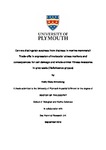Can we distinguish eustress from distress in marine mammals? Trade-offs in expression of molecular stress markers and consequences for cell damage and whole-animal fitness measures in grey seals (Halichoerus grypus)
| dc.contributor.supervisor | Briffa, Mark | |
| dc.contributor.author | Armstrong, Holly Clare | |
| dc.contributor.other | School of Biological and Marine Sciences | en_US |
| dc.date.accessioned | 2019-09-09T15:33:20Z | |
| dc.date.issued | 2019 | |
| dc.date.issued | 2019 | |
| dc.identifier | 10474811 | en_US |
| dc.identifier.uri | http://hdl.handle.net/10026.1/14900 | |
| dc.description.abstract |
The ability to respond adequately to stress is crucial to an organism’s survival and fitness. Stress influences reproductive success, development, energy balance and immune responses and thus shapes life histories, population dynamics and evolutionary trajectories. Little is known about the links between cellular and whole-animal physiological stress responses in marine mammals, and their impact on tissue damage and fitness. Although stress responses may be activated under specific conditions, we need to recognise that the induction alone does not always represent a state of distress. If we are to understand the role of stress as a driver of individual health, population dynamics and life history trajectories we need to be able to distinguish between eustress and distress at the whole-animal and cell levels. This thesis aimed to investigate the causes of cellular stress responses in tissues essential to fitness and survival of grey seal adult females and pups, which are routinely exposed to natural and anthropogenic stressors, and consequences for cell damage and trade-offs in energy investment at the whole-animal level. Grey seals experience numerous physiologically stressful states throughout development and adulthood that induce cellular defences in other species. This includes fasting during the energetically demanding lactation and developmental periods, and large seasonal fluctuations in fat stores with consequently significant variations in adipocyte size. Individual cellular stress responses to ‘life-style’ stressors may affect grey seals’ ability to cope with additional stress, such as disease, disturbance and contaminants in prey. The studies in this thesis investigated the nutritional and developmental changes in gene expression of key cellular defences, heat shock proteins (HSPs) and redox enzymes (REs), and to explore the role of intrinsic and extrinsic stressors in their induction at the gene expression level, in two vital tissues, blubber and leukocytes. Malondialdehyde (MDA) concentration (a marker of oxidative damage) was also used to measure tissue-level damage in blubber. Chapter 1 reviews current knowledge regarding eustress and distress in tissues and cells of marine mammals, with a focus on grey seals. Chapter 2 provides detailed methods that are utilised in this thesis to answer questions regarding causes of cellular stress and consequences for tissue function and whole animal health, filling knowledge gaps identified by Chapter 1. Chapter 3 and Chapter 4 consider relative gene expression of cellular stress markers (HSPs and REs) in blubber of breeding and pre-breeding females and pups during suckling and the post-weaning fast, respectively, because blubber is a key tissue in energy balance. Chapter 5 examines the same gene expression in leukocytes of both lactating-fasting females and pups, because animals may experience a trade-off between stress responses and immune function when resources are limited. These chapters identify nutritional and developmental causes of expression of cellular defences, and consider relationships with markers of tissue damage (MDA concentration) and whole-animal fitness. Chapter 6 used an experimental approach to examine causal relationships between GC and PCBs, and HSP gene expression in blubber. Identifying vulnerable life-history stages of grey seals, when animals experience specific additional stressors as ‘distress’, requires correct interpretation of markers of cellular stress. This is essential to potentially inform management of seal populations by predicting population level consequences of exposure to specific stressors. | en_US |
| dc.description.sponsorship | School of Biological and Marine Sciences PhD Studentship (internal; was School of Marine Science and Engineering PhD Studentship) | en_US |
| dc.language.iso | en | |
| dc.publisher | University of Plymouth | |
| dc.rights | Attribution 3.0 United States | * |
| dc.rights.uri | http://creativecommons.org/licenses/by/3.0/us/ | * |
| dc.subject | Stress | en_US |
| dc.subject | Grey seal | en_US |
| dc.subject | Trade-offs | en_US |
| dc.subject | Molecular markers | en_US |
| dc.subject | Fitness | en_US |
| dc.subject | Adipose tissue | en_US |
| dc.subject | Cellular stress | en_US |
| dc.subject | Whole-animal stress | en_US |
| dc.subject | Heat shock proteins (HSPs) | en_US |
| dc.subject | Redox enzymes (REs) | en_US |
| dc.subject | Energy balance | en_US |
| dc.subject | Marine mammal | en_US |
| dc.subject | Gene expression | en_US |
| dc.subject | Blubber | en_US |
| dc.subject | White blood cells | en_US |
| dc.subject | Physiology | en_US |
| dc.subject | Oxidative tissue damage | en_US |
| dc.subject.classification | PhD | en_US |
| dc.title | Can we distinguish eustress from distress in marine mammals? Trade-offs in expression of molecular stress markers and consequences for cell damage and whole-animal fitness measures in grey seals (Halichoerus grypus) | en_US |
| dc.type | Thesis | |
| plymouth.version | publishable | en_US |
| dc.identifier.doi | http://dx.doi.org/10.24382/1131 | |
| dc.rights.embargodate | 2020-09-09T15:33:20Z | |
| dc.rights.embargoperiod | 12 months | en_US |
| dc.type.qualification | Doctorate | en_US |
| rioxxterms.version | NA |
Files in this item
This item appears in the following Collection(s)
-
01 Research Theses Main Collection
Research Theses Main



